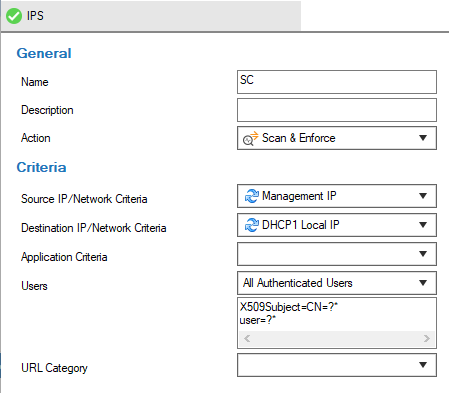Configure IPS scanning policies to control the behavior of the IPS engine when an attack is detected. By default, all access rules use the default IPS policy. You can also customize the default settings or create custom IPS policies to apply to your access rules. Each of the created policies can be applied individually.

For information on how to customize default policy profiles, see How to Configure Policy Profiles.
Before You Begin
Make sure that SSL Inspection is enabled in the Security Settings. For more information, see How to Configure Outbound SSL Inspection.
Create an IPS Policy Profile
Create an explicit IPS policy profile to match individual requirements.
- (On the Control Center) Go to CONFIGURATION > Configuration Tree > Multi-Range > Global Settings > Global Firewall Objects.
- Click Lock.
- In the left menu, expand Policy Profiles.
Select IPS.
- To add a new policy profile, click the plus icon (
 ) at the top right of the window, enter a profile name, and click OK.
) at the top right of the window, enter a profile name, and click OK.
- Click Send Changes and Activate.
The policy profile now appears in the IPS Shared Policy Profiles list, and you can create explicit policies for it.
Create an Explicit IPS Policy
- (On the Control Center) Go to CONFIGURATION > Configuration Tree > Multi-Range > Global Settings > Global Firewall Objects.
- (On a CloudGen Firewall) Go to CONFIGURATION > Configuration Tree > Box > Assigned Services > Firewall > Forwarding Rules.
- Click Lock.
- In the left menu, expand Policy Profiles.
Select IPS.
- Select the profile you wish to create the policy for. The policy list appears under the corresponding tab in the lower window.
- To add a new policy, click the plus icon (
 ) at the top right of the lower window. You can also right-click the list and select Add Policy.
) at the top right of the lower window. You can also right-click the list and select Add Policy. - Specify values for the following:
- Name – Enter a descriptive name for the explicit policy.
- Description – Enter a description for the policy.
- Action – Select an action.
- Do Not Scan– IPS does not scan traffic matching the criteria.
- Scan & Log– IPS only scans and logs the events.
- Scan & Enforce – IPS is enforced.
- Source / Destination IP/Network Criteria – Select the source and destination network, or select <Explicit Network> and enter an IP address / network or a domain that gets resolved to an IP address for the matching.
- Application Criteria – Define the application match condition. Add an application the policy should apply to, or create explicit applications. To open the selection menu, double-click the corresponding field. Selecting applications in the application editor works similar to the process in the objects configuration for the application rule set. For more information, see How to Create an Application Object and How to Create a Custom Application Object.
- Users – Select the users or groups the policy should apply to.
- URL Category – Specify URL categories the policy should apply to.
- Click OK.

- Click Send Changes and Activate.
The policy is now listed in the lower window can be selected as Policy in your forwarding rules. For more information, see the last step in How to Configure Policy Profiles.
